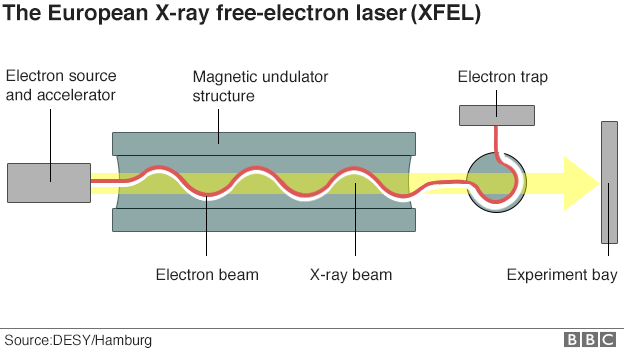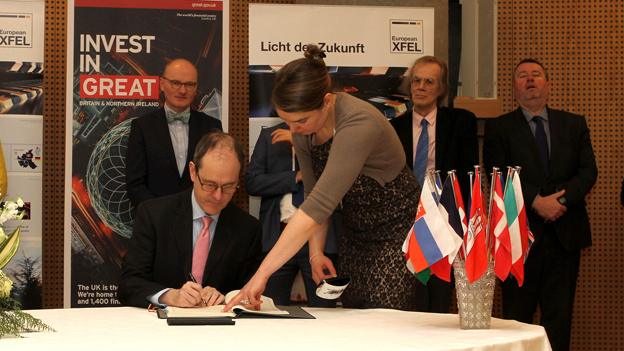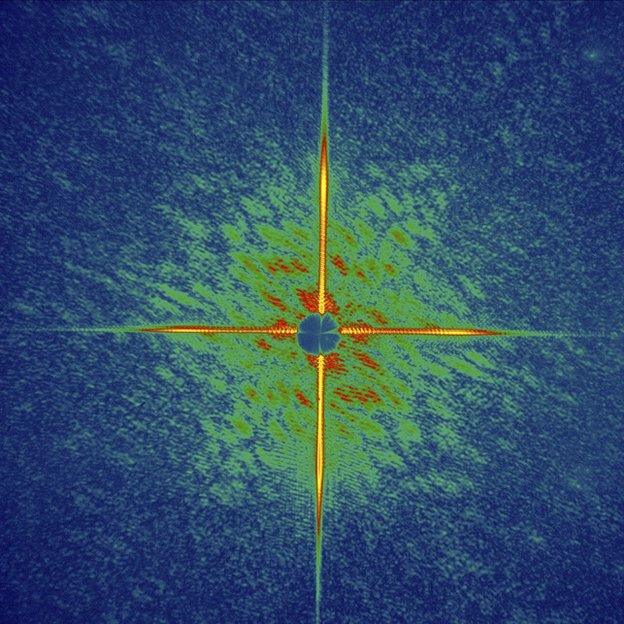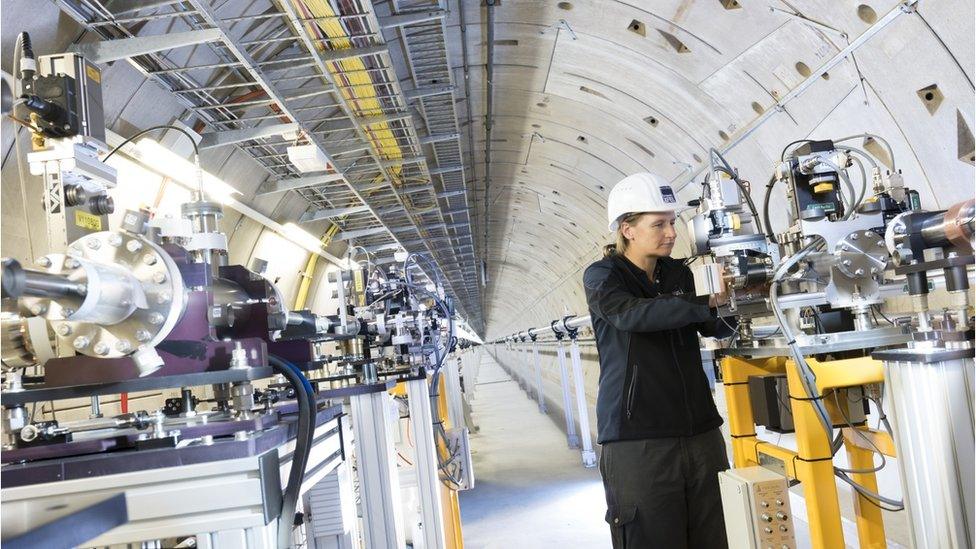XFEL: UK signs up to super X-ray laser machine
- Published
Allen Orville: "An XFEL opens up a new frontier in structural biology"
The UK has formally joined the European XFEL, external, a super-bright X-ray laser.
The machine, which is sited in Germany, produces high-energy pulses that are focussed on a target at the end of a 3.4km-long tunnel complex.
These X-ray shots instantly destroy that target but just as they do so they also capture its deepest structure.
Scientists will use the machine to make movies of biological and chemical reactions as they happen at the atomic scale - among myriad applications.
New drugs and new types of materials with novel properties are almost certain to follow from these intricate and detailed investigations.

XFEL began experiments last year. Getting beam time is a very competitive process
Dr Allen Orville, who leads the team set up to prepare British scientists to use the facility, says XFELs represent a paradigm shift for research.
"And it's really true: you blow up the sample with the X-ray pulse," he chuckles. "But that's OK because the data is in the X-ray photons and they travel at the speed of light, whereas the sample blows up only at the speed of sound," he told BBC News.
Many nations around the world employ circular machines called synchrotrons that do very similar sorts of work.
Large crystals of biomolecules, say, are put in the path of a tightly focussed X-ray beam and the way this light is then bent betrays the arrangement of atoms in the target sample. But the X-rays generated by the linear XFEL are about a billion times brighter than in the circular laboratories.
What also sets the XFEL apart is the super-fast time structure in its flashes.
It will deliver trillions (1,000,000,000,000) of X-ray photons in a pulse lasting just 50 femtoseconds (0.000,000,000,000,05 sec).
Two-thousand-seven-hundred of these pulses are organised into bunches that then strike the target at a rate of 10 a second.

How to make super-bright flashes

At the head of the XFEL, bunches of electrons are first sped up to near-light-speed in a super-cold, evacuated accelerator
The particles are directed down long undulators - magnetic systems that produce a slalom course for the electrons
As they wiggle back and forth in the undulators, the fast-moving electrons emit very bright X-ray flashes
The particles interact with this great sea of X-rays and begin to organise themselves into even tighter groupings
This intensifies the brilliance of their emission and gives it coherence - the X-rays are "in sync" and laser-like
Having done their job, the electrons are siphoned off, leaving the X-ray flashes to hit their experimental targets

It allows for time-resolved investigations that are beyond what is possible in standard synchrotrons. For example, scientists will use a jet to stream a slurry of tiny crystals in front of the beam, priming them with another laser so that chemical reactions are triggered at just the right moment to be caught by the pulses.
"We've developed a method called acoustic droplet ejection (ADE)," explains Dr Orville.
"We eject small droplets - nano-litres-worth of droplets, maybe pico-litres-worth of droplets - through the air directly into the beam, or on to a conveyor belt that brings the droplets into the beam.
"And the beauty of that second system, where we launch on to a tape drive to bring the droplets into the beam, is that it allows us to separate the time structure for initiating a reaction from the interaction zone. So, we can actually queue up a whole series of droplets - and as they progress towards the X-ray machine, they get a little bit older; they get further into the reaction cycle."
XFELs permit scientists to watch high-speed biology in action, to follow every step in complex catalytic processes such as photosynthesis in plants.

Sir Sebastian Wood, Britain's Ambassador to Germany, makes the UK an XFEL shareholder
Britain is handing over a £30m up-front membership fee to be part of the Hamburg-based XFEL and will be paying a further £2.5m a year towards operating costs. But there are in-kind contributions as well.
The UK has already delivered an advanced camera called the Large Pixel Detector. It collects the diffracted X-ray photons passing through samples at a rate of 4.5 million frames per second.
Membership was sealed in a ceremony on Monday in Berlin where Sir Sebastian Wood, Britain's Ambassador to Germany, signed the accession documents.
The UK had indicated when the European XFEL project was first approved back in 2007 that it wanted to be a shareholder, but this desire got knocked sideways almost immediately by the global financial crisis.
A renewed commitment was then made in 2014 and the Berlin signature now makes it concrete.

X-rays passing through a sample produce a diffraction pattern that betrays the atomic structure
The organisation that oversees British science - the UKRI (UK Research and Innovation) - recently initiated a road-mapping exercise, external that aims to set out which facilities the country should be involved in, both at home and abroad.
The key is to identify long-term preferences, such as the European XFEL, the LHC and the forthcoming giant astronomy telescope known as the Square Kilometre Array.
"We want out investments to be on a considered, long-term basis," said Dr Brian Bowsher, the chief executive of the Science and Technology Facilities Council, external, which comes under the UKRI.
"In the past I think we may have reacted to events without looking at them in the round. And I think the production of the infrastructure roadmap will be really helpful to the UK science community."
The UK's Science Minister, Sam Gyimah, said: "The incredible XFEL will help us better understand life threatening diseases by using one of the world's most powerful X-ray machines. Working with our international partners, the super-strength laser will help develop new medical treatments and therapies, potentially saving thousands of lives across the world.
"Through our modern Industrial Strategy, we are investing an extra £4.7bn into research and development. I am determined that we continue to secure our position as being a world-leader in science, research and innovation and I can't wait to see the results that come from our participation in this extraordinary project."

With the UK's accession, there are now 12 countries involved under Germany's leadership
UK scientists cannot just tip up in Hamburg and expect to get beam time on the XFEL. They must earn it. There are more than 50 groups across the country now working with Dr Orville's hub at the UK's Diamond synchrotron in Harwell, external, Oxfordshire.
His aim is to make their bids for beam time as compelling as possible.
"The Diamond XFEL hub, external has multiple roles: we'll help characterise your samples; we'll help you get preliminary data; we'll help you make that peer review proposal. And if you get beam time, we'll even help you collect the data. We go from the beginning of the experiment all the way through to publication," Dr Orville told BBC News.
The UK hopes soon to set up a fibre link between Hamburg and Harwell so that data gathered in the XFEL can be brought back to the British centre for immediate analysis.
Jonathan.Amos-INTERNET@bbc.co.uk, external and follow me on Twitter: @BBCAmos, external